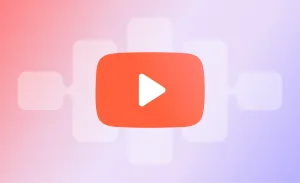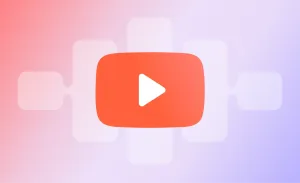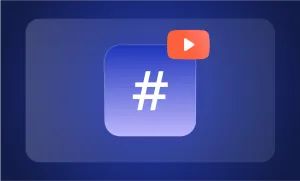You’ve worked super hard on your YouTube videos, your editing looks great, and the stuff you share is really cool. It’s all perfect yet your videos seem to be stuck with a low view count.
If that’s the case, you’ll need to make some changes to help your videos show up higher in search results. That way, more people will see, click, and watch them.In this post, we’ll share simple tips to improve your new and old videos so they get more views. These tricks will make it easier to find more videos and make them more exciting to click on!
What is YouTube SEO?
Whenever someone is looking for a video, they probably do one of these two things:
- Search on Google: When they search for something on Google, they’ll see videos listed along with other websites. Most of these videos are from YouTube because Google thinks they fit what people are looking for.
- Search on YouTube: If they go to YouTube directly, they use YouTube’s search engine to find videos.
Both paths can lead people to your videos — but only if YouTube SEO is working in your favor. If you work on YouTube SEO properly, your videos might show up in both places!
That’s because YouTube SEO helps Google and YouTube understand what your video is about so they can suggest it to people searching for that topic.


More people seeing your videos = more views = more subscribers and growth!
How to Get Your Videos to Show Up in Search Results
There are three key steps to improve your video’s SEO:
1) Keyword research
2) Optimizing for discoverability
3) Optimizing to get more clicks
4) Optimizing for retention and engagement
For each of these sections, we’ll discuss the details of what you need to do for your YouTube SEO strategy to be effective.
1) Keyword Research
The first step is to find the right keywords so you can understand what people are searching for. It’ll help you create content around it and add it in key places so that your videos become more relevant and discoverable.
If you don’t use the right keywords, your videos might not attract viewers even if you have the most engaging content on the topic.
So, which keywords should you use? Before we get into finding relevant keywords, let's take a look at the different types of keywords:
Long-Tail Keywords
These are longer, more specific phrases that target niche topics. They might not get tons of searches, but they attract people who know exactly what they’re looking for. For example, if someone searches for some cooking content, like "How to make vegan chocolate chip cookies without sugar," they’re probably ready to bake.
Medium-Tail Keywords
These keywords hit the sweet spot between being too broad and too specific. They have a decent amount of searches and aren’t as hard to rank for. An example would be "Best vegan cookie recipes."
Short-Tail Keywords
These are super broad terms, usually just one or two words. While lots of people search for them, they also come with heavy competition. Think of terms like "vegan desserts" or "cookie recipes."
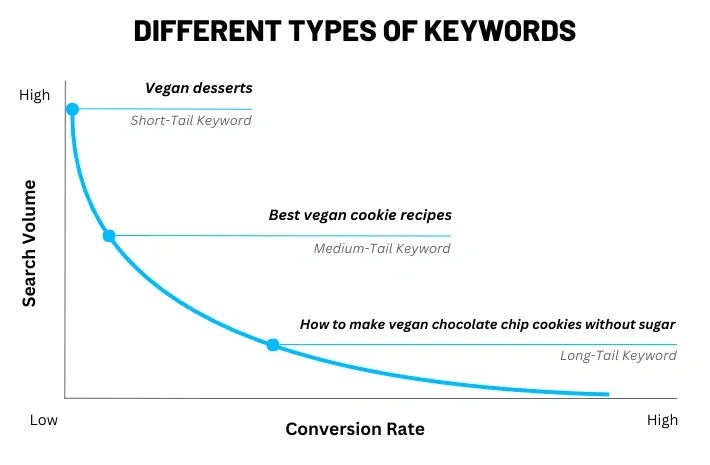
How These Keywords Affect Rankings
- Using long-tail keywords can boost your rankings because they target specific searches with lower competition.
- Medium-tail keywords provide a balanced opportunity, helping you rank well while attracting a solid audience.
- Short-tail keywords can be tough to rank for since many others use them, but if you succeed, they can drive significant traffic to your content.
Keyword Research for Existing Videos
If your existing videos aren't performing well, you might need to revisit your keyword strategy. Here are some effective strategies to identify the best keywords for your content:
1) Brainstorm terms directly related to your video content
Think about what words or phrases best describe your video. Consider what your target audience might type into the search bar.
3) Use YouTube's search bar for autocomplete suggestions
Start typing a phrase related to your video in YouTube's search bar. The autocomplete suggestions will show you popular searches, helping you identify relevant keywords.
4) Analyze titles of popular videos in your niche
Look at what successful videos in your category are titled. Take note of any common phrases or keywords that seem to attract views.
5) Review your video's comments for terms viewers use
Check the comments section of your videos to see what words or phrases viewers are using. This can give you insight into what your audience is interested in.
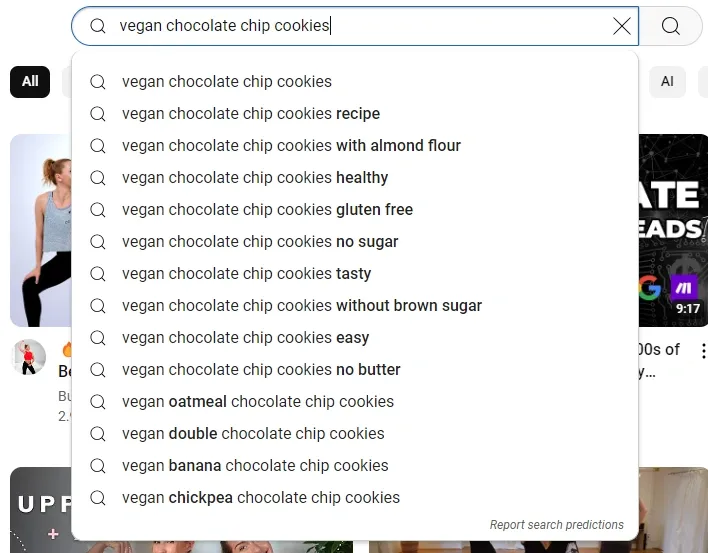
Where to Use the Main Keyword for Your Existing Videos
Once you’ve identified the main keyword, use it at the following places:
- Video Title: Make sure your primary keyword is in the title. This helps both viewers and YouTube understand what your video is about.
- Description: Include your main keywords naturally in the video description. This is a great place to elaborate on your video content and make it easier for people to find.
- Tags: Use relevant keywords in the tags section. This helps YouTube categorize your video and show it to viewers interested in similar topics.
When it comes to using keywords effectively, it’s important to strike the right balance. YouTube’s algorithm prefers natural language, so focus on clarity and relevance. If you overstuff your keyword, it might give a poor user experience and may even hurt your video's ranking.
Also, keep in mind that misleading keywords can lead to high bounce rates, as viewers may leave your video if it doesn’t deliver what they expect. This can negatively impact your rankings over time.
Keyword Research for New Videos
Finding the best keywords on YouTube isn't difficult, but it can be time-consuming. Using a YouTube keyword tool can significantly speed up the process and provide valuable insights.
These tools offer detailed information about various keywords, including:
- Monthly Search Volume: How many times a keyword is searched in a month, indicating its popularity.
- Competitiveness: A score that shows how many other videos are targeting the same keyword, helping you assess your chances of ranking.
- Related Keywords: Suggestions for similar keywords that you might want to consider.
- Questions People Ask: Common questions related to the keyword, giving you ideas for video content.
- Overall Keyword Score: An assessment combining search volume and competitiveness to help you choose the best keywords.
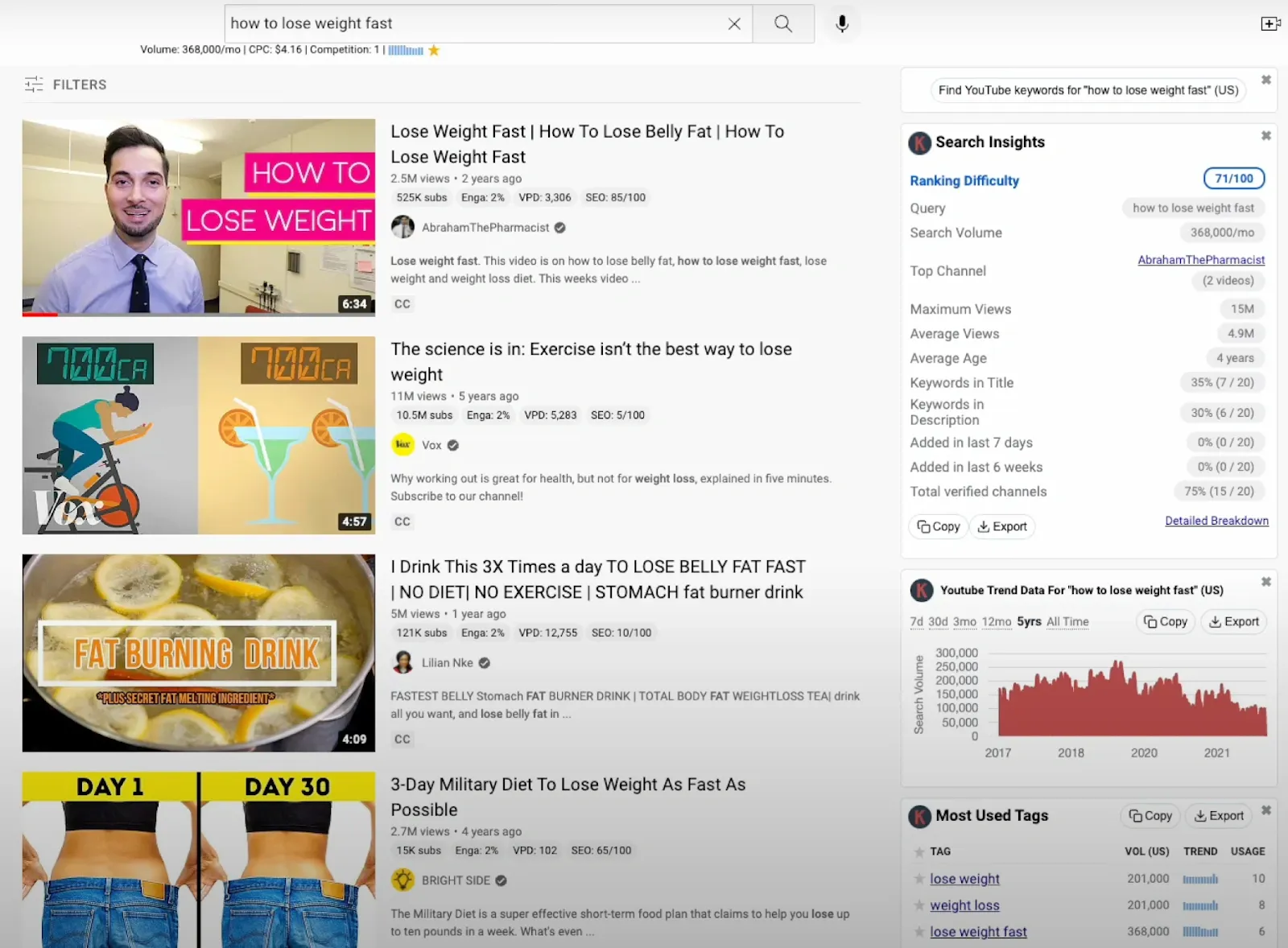
Pro Tip: When you’re planning new content, focus on finding "low-hanging fruits"—keywords that have high search volume but low competition. It’ll allow you to target keywords that can attract viewers without getting lost among countless other videos.
Best Tools for YouTube Keyword Research
When researching keywords for YouTube, it's crucial to use tools designed specifically for the platform. Google search volume and competition data may not provide accurate insights since YouTube has its own unique search patterns and trends. Here are two top tools to help you find the best keywords:
1) TubeBuddy (Budget-Friendly Tool)
TubeBuddy is a handy tool that helps you grow your YouTube channel easily. It works as a browser extension, linking directly to your YouTube dashboard.

Before you upload your videos, TubeBuddy gives you great suggestions for keywords, captions, and tags to make your content easy to find. It also helps you analyze the best time to publish posts, viewer retention, and create eye-catching thumbnails.
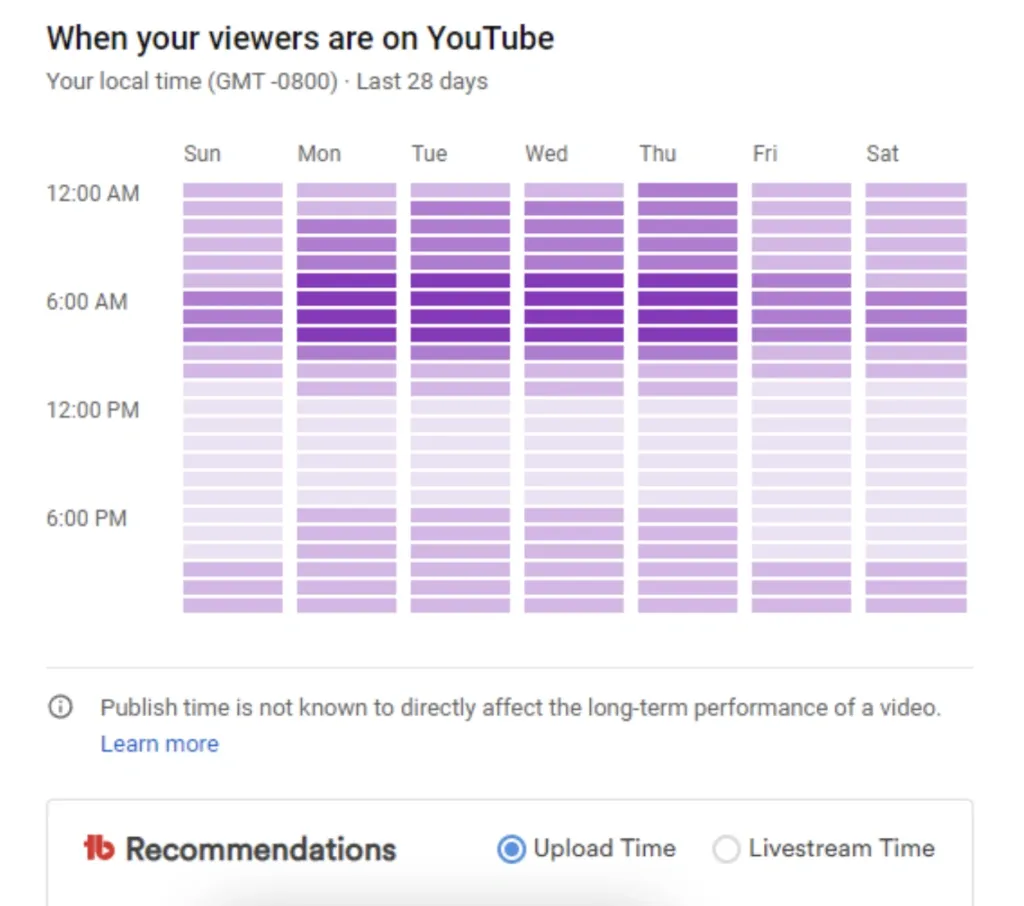
With its powerful features and flexibility, TubeBuddy is a go-to choice for anyone looking to improve their subscriber count and engagement.
Key features
– Keyword research and optimization
– Bulk processing for titles, descriptions, and tags
– Thumbnail A/B testing
– Competitor analysis
– AI-based recommendations for improved CTR
Pricing
– Pro: $3.75/month
– Legend: $16.50/month
– Enterprise: Bundle pricing
2) VidIQ (Popular Alternative)
VidIQ offers a comprehensive set of tools for YouTube optimization. It includes features for keyword research, competitor analysis, and channel audits. The suite also boasts AI-powered tools for creating thumbnails, generating scripts, and optimizing tags.
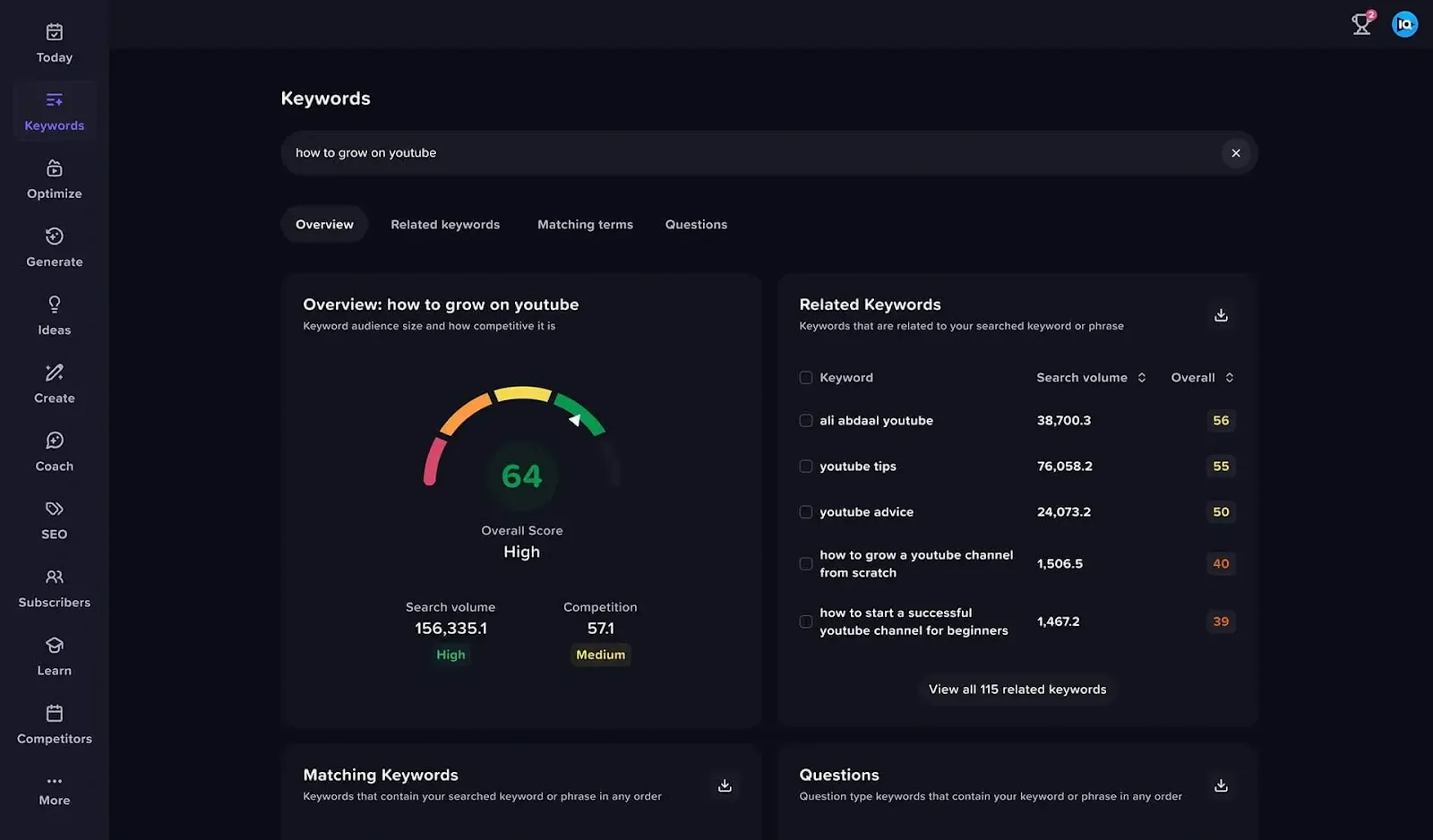
With its user-friendly interface and affordable pricing, VidIQ is popular among both beginners and experienced content creators.
Key Features
– Real-time analytics dashboard
– Keyword research and trend analysis
– Competitor tracking
– Video SEO scorecard
– AI-powered thumbnail and script generator
Pricing
– Boost: $16.58/month
– Coaching: $99/month
2) Optimize Videos for Discoverability
Once you find your keywords, the next step is to use them wisely. This is super important for getting your videos noticed and making sure the right people see them. When you use keywords correctly, it helps YouTube and viewers understand what your video is about, which can lead to more views.
Some things you'll want to optimize are:
1) Titles
Put your main keyword at the beginning of the title to make it easier to find. Keep it clear and interesting. For example, instead of saying "A Guide to Baking Cookies," say "Baking Cookies: Easy Vegan Cookie Recipes." Using exact-match keywords helps your video show up when people search for those specific phrases.
2) Descriptions
Use your main keyword in the first few lines of your video description. This tells YouTube what your video is about. You can also include related keywords throughout the description for extra context.

3) Tags
Add your main keyword and some related keywords as tags. This helps YouTube categorize your content so it can show it to people interested in similar topics.
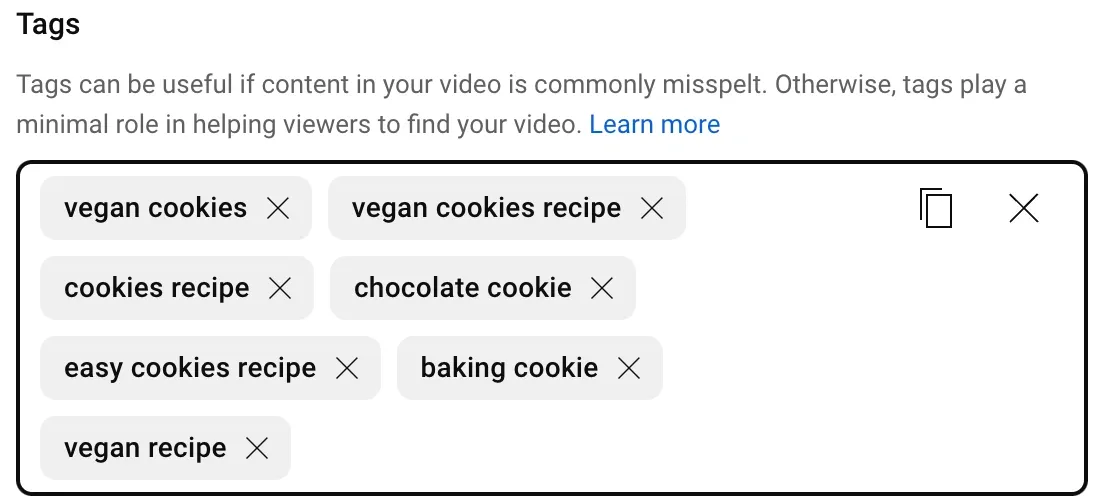
3) Optimize Videos for CTR (Click-Through Rate)
Optimizing for CTR means making your video more likely to get clicked when it appears in search results.
Here are some ways to do that:
1) Catchy Thumbnails
Make bright and bold thumbnails with clear images and easy-to-read text. For example, a thumbnail with a fun background and a big question like "Can You Bake Without Eggs?" can grab people's attention.
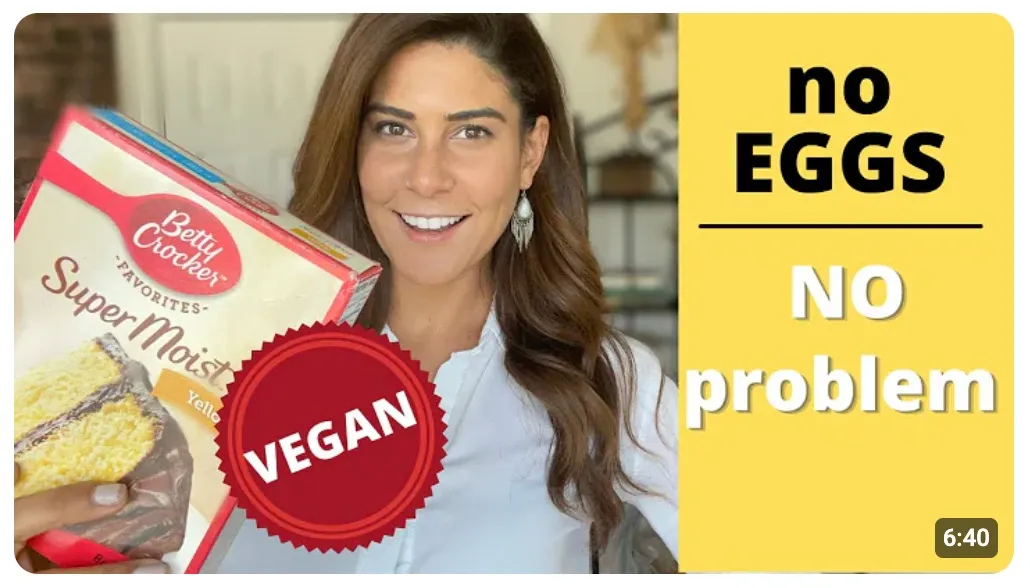
2) Clickbait Titles (but not too clickbait)
You want to be honest, but you can use titles that make people curious to get more clicks. Instead of just saying "Vegan Cookie Recipes," try "You Won't Believe These 5 Vegan Cookie Recipes!" This can make viewers want to learn more.

Commenting on this, Gianluca Ferruggia, General Manager at DesignRush, explained how their team finalizes titles for podcast episodes.
"People are naturally curious, and when a headline hints at a gap in their knowledge, they can’t resist finding out more. We've seen engagement rates jump 20-30% simply by restructuring titles to either challenge assumptions or promise surprising insights," Ferruggia explained.
This deliberate framing, according to Ferruggia, taps into viewers' natural desire to resolve unanswered questions. It’s a smart way to turn curiosity into clicks.
4) Optimize Videos for Retention and Engagement
Keeping viewers engaged is super important because people's attention spans are getting shorter. If you don’t grab their attention in the first minute, they might leave your video, which can hurt your rankings.
1) Start With a Strong Hook
Starting with a strong hook in the first minute is key. A hook is something that grabs attention and makes viewers want to stick around. If your hook isn't catchy, they might click away or close the video.
Here are some kinds of hooks that work:
1) Ask a Question
Kick off your video with a question that sparks curiosity. For instance, you could say, "Ever wondered why your YouTube views suddenly skyrocket? Let's uncover the secret!"
2) Share a Surprising Fact
Begin with an interesting tidbit related to your topic. Try something like, "Did you know that changing just one word in your title can double your click-through rate?"
3) Promise a Benefit
Tell your viewers what they'll gain from watching. You might say, "Stick around to learn the three tricks that could boost your subscriber count by 50% in just one month!"
4) Strong Visuals
In the first few seconds, use eye-catching visuals to hook your viewers. You could show a quick montage of a channel's subscriber count rapidly increasing, or a time-lapse of video views climbing. Think about popular tech channels - they often use sleek graphics and dynamic animations to instantly grab your attention.
2) Provide Value Quickly
After you've grabbed your viewers’ attention with a strong hook, the next crucial step is to deliver real value right away. This is your chance to show them why they should stick around for the rest of the video. Here’s how to make that first minute really count:
3) Deliver Key Information First
Once you’ve hooked your audience, jump straight into the main points. Get to the heart of what you’re offering. For example, if you’re showing how to create a fun DIY project, you could quickly outline what they can expect by saying:
– What You'll Learn: How to make a personalized photo frame.
– Materials Needed: Simple supplies you probably already have at home.
– Steps to Follow: Three easy steps to complete your project.
– Why It’s Great: A fun way to display your favorite memories!
According to research by long-term SEO strategy experts at SEOProfy, this is a foolproof, tried-and-tested formula for the first 15 seconds of the video. It should either have an unexpected fact, eye-catching visuals, or fast-paced editing.
By A/B testing this approach, SEOProfy’s research noticed a sizeable boost to their videos, with the average viewer retention jumping from 35% to 68%
4) Use Storytelling to Engage Viewers
After you've grabbed your viewers with a great hook, storytelling will keep them watching. Good storytelling can make your content more engaging, relatable, and memorable. Here’s how you can use storytelling in your fun DIY project videos:
Tip #1: Share Your Own Experiences
Talk about a time when you tried a fun DIY project that didn't go as planned. For example, maybe you decided to make a colorful tie-dye shirt but accidentally used too much dye and ended up with a mess. Share what you learned from that experience, like how to control the dye better or what materials worked best. This personal touch helps your audience connect with you and feel like they're part of your journey.
Tip #2: Create a Narrative Arc
A narrative arc is a structure that outlines how a story unfolds. It helps guide the audience through a beginning, middle, and end, creating a satisfying experience. In video content, using a narrative arc makes your message clearer and keeps viewers engaged from start to finish.
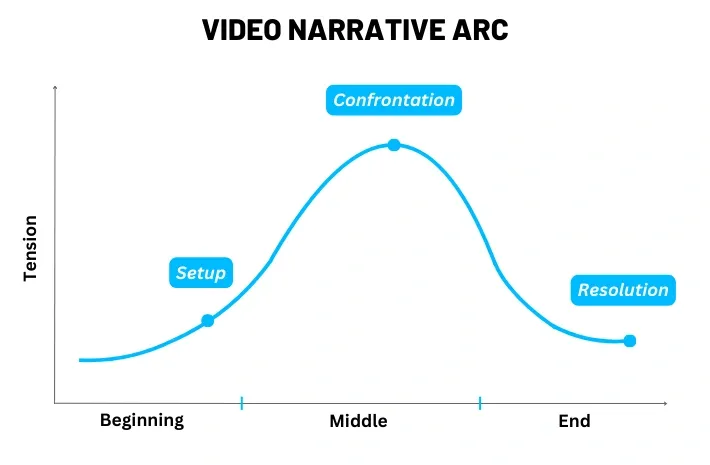
Beginning (Setup)
– Introduce the main characters and the central problem.
– Grab attention with an interesting hook (e.g., your inspiration or challenge).
Middle (Confrontation)
– Build tension by showcasing struggles and obstacles.
– Share mistakes and lessons learned to keep viewers invested.
End (Resolution)
– Reveal the solution or successful outcome.
– Reflect on lessons learned and inspire viewers to take action.
By following this narrative arc, you keep your viewers curious about how you figured everything out, making them more likely to stick around for the entire video.
Tip #3: Use Visuals to Enhance the Story
Show, don't just tell. If you're explaining how to make the photo coasters, include clips of the process: gathering materials, designing the coasters, and the final reveal. This not only illustrates your points but also keeps viewers visually engaged. You can even show a time-lapse of the whole project to capture attention and make it more dynamic.
5) Keep the Energy Up
The way you present yourself on camera can have a big impact on how your viewers connect with your content. When you talk about your topic with genuine excitement and passion, it creates an engaging atmosphere that can really draw people in. Your enthusiasm can be infectious - if you're truly excited about what you're sharing, your audience is more likely to get excited too.
To show your passion effectively, think about how you're speaking. Use a lively and upbeat voice to highlight important points and express your emotions. Also, don't forget about your face - a wide smile or raised eyebrows can really show your enthusiasm and keep viewers interested.
How you interact with the camera matters too. Try using hand gestures to emphasize key ideas, and if you can, move around a bit. This can make your presence on camera more dynamic. When you put all these elements together, your audience will likely feel more connected to you and engaged with what you're saying.
Remember, the energy you bring sets the tone for your whole video! So bring your authentic excitement to the camera, and your viewers will be more likely to stay tuned in and come back for more of your content.
6) Encourage Engagement
Get viewers to engage with your video by asking questions or encouraging them to comment. Here are a couple of strategies:
1) Call to Action
After explaining a recipe step, you could say, "What’s your favorite cookie flavor? Let me know in the comments below!" You could even add in the description section. This invites them to share their thoughts and can lead to more comments, likes, and shares.
2) Examples
You could challenge viewers to try the recipe and share their results. For example, "Try this recipe and tag me in your photos on Instagram!" This not only encourages comments but also interaction on social media.
3) Responding to Comments
Engage with your viewers by responding to their comments. If someone asks a question or shares their experience, take the time to reply. This shows you care and encourages others to join the conversation.
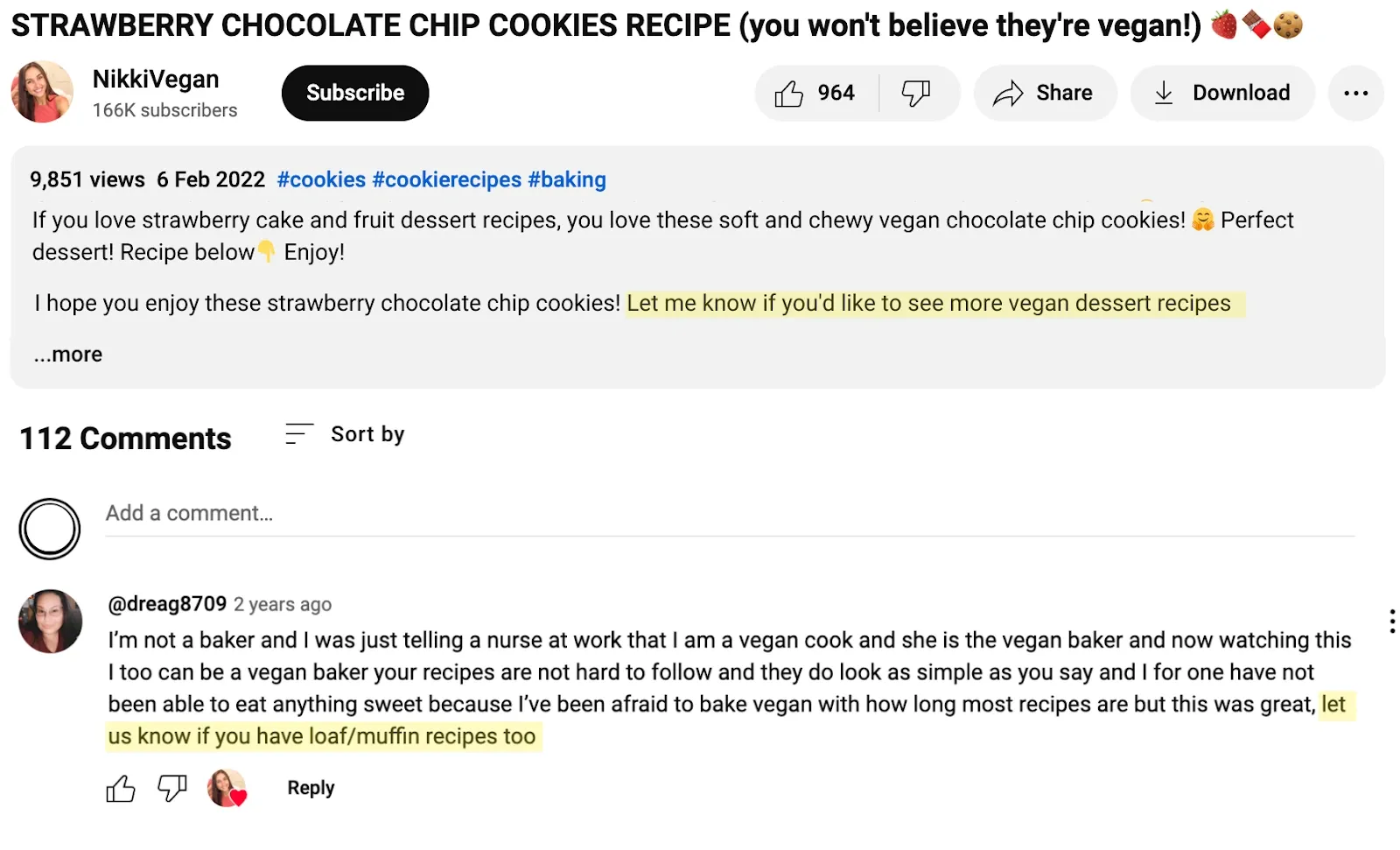
Stay Compliant with Copyright Laws
While trying to make your videos more engaging and discoverable, keep YouTube’s copyright laws in mind. If you end up stealing other people’s videos, it could cause serious legal issues and reputational harm.
When it comes to using someone else's work, what's okay in one country might not be okay in another. Each country still has its own rules about copyright exceptions.
“In many European countries, you can only use someone's work without permission if it fits into specific categories, like quoting, criticizing, or making a parody. Countries like Canada, the UK, and Australia have a system called 'fair dealing.' This mixes the idea of weighing different factors, as they do in the US, with specific allowed uses,” says Matthew Clark, a US-based lawyer from the Clark Law Office.
In the end, it's up to the courts to decide if a particular use is allowed or not, looking at each situation separately.
How to Stay Safe:
- Use Royalty-Free Content: Stick to royalty-free music, stock footage, and images.
- Give Credit Where It's Due: If you use others' content with permission, credit them properly.
- Create Original Content: Focus on making unique videos to avoid risks and build a brand that viewers can trust.
Final Thoughts
To help your YouTube videos rank better, use relevant keywords throughout your content, including in your title and description. This helps YouTube understand what your video is about.
Make sure to write a clear, engaging description and use a catchy thumbnail to attract viewers. Encourage your audience to like, comment, and subscribe, as this interaction can boost your video’s visibility.
Finally, if you’re looking to make the video creation process easier, check out Podcastle. With tools tailored for YouTube creators, Podcastle simplifies everything from recording to publishing:
– Use AI upscaling to enhance video quality, ensuring your content looks sharp and professional on any screen.
– With the background blurring feature, you can keep the focus on you, minimizing distractions
– Instant video resizing makes it effortless to adapt your content for YouTube Shorts or other formats without losing quality.
Podcastle even offers noise cancellation for crystal-clear audio, helping your videos stand out. Give it a shot and see how much smoother your YouTube workflow can be!






